Psoriasis (sore-EYE-ah-sis) is a chronic (long-lasting) disease. It develops when a person’s immune system sends faulty signals that tell skin cells to grow too quickly. New skin cells form in days rather than weeks.
The body does not shed these excess skin cells. The skin cells pile up on the surface of the skin, causing patches of psoriasis to appear.
Psoriasis may look contagious, but it’s not.
You cannot get psoriasis from touching someone who has it. To get psoriasis, a person must inherit the genes that cause it.
Types of psoriasis
If you have psoriasis, you will have one or more of these types:
- Plaque (also called psoriasis vulgaris).
- Guttate.
- Inverse (also called flexural psoriasis or intertriginous psoriasis).
- Pustular.
- Erythrodermic (also called exfoliative psoriasis).
Some people get more than one type. Sometimes a person gets one type of psoriasis, and then the type of psoriasis changes.
Signs and symptoms
What you see and feel depends on the type of psoriasis you have. You may have just a few of the signs and symptoms listed below, or you may have many.
Plaque psoriasis
also called psoriasis vulgaris)
- Raised, reddish patches on the skin called plaque (plak).
- Patches may be covered with a silvery-white coating, which dermatologists call scale.
- Patches can appear anywhere on the skin.
- Most patches appear on the knees, elbows, lower back, and scalp.
- Patches can itch.
- Scratching the itchy patches often causes the patches to thicken.
- Patches vary in size and can appear as separate patches or join together to cover a large area.
- Nail problems — pits in the nails, crumbling nail, nail falls off.
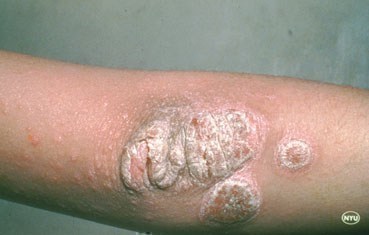
Plaque psoriasis: This type of psoriasis often causes thick patches of skin that are covered with silvery-white scales.
Guttate psoriasis
- Small, red spots (usually on the trunk, arms, and legs but can appear on the scalp, face, and ears).
- Spots can show up all over the skin.
- Spots often appear after an illness, especially strep throat.
- Spots may clear up in a few weeks or months without treatment.
- Spots may appear where the person had plaque psoriasis.
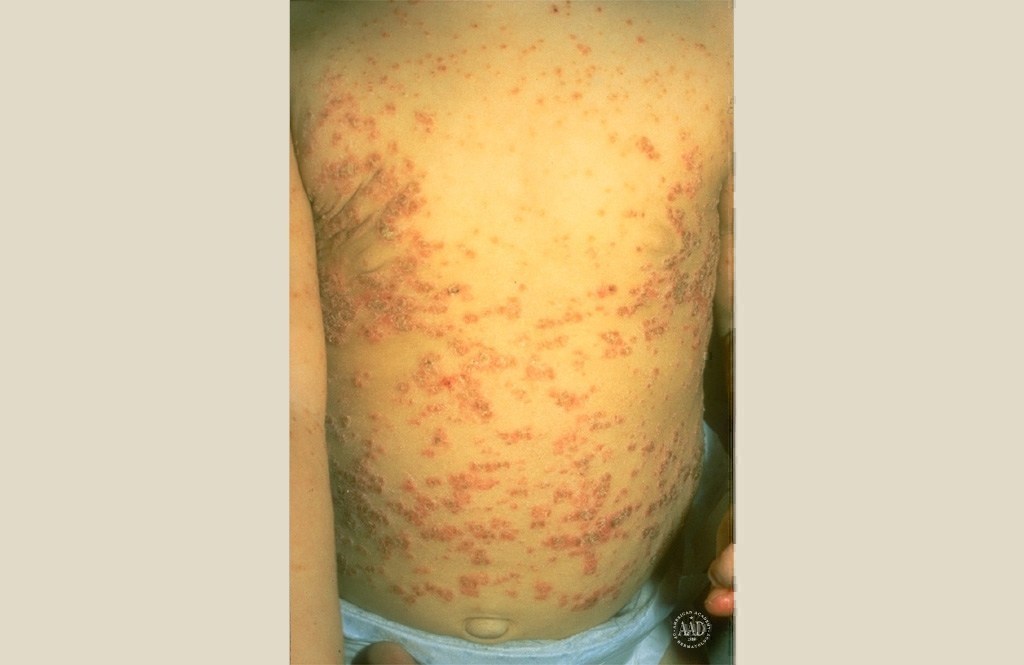
Guttate psoriasis: This type of psoriasis causes small spots that can show up all over the skin.
Pustular psoriasis
- Skin red, swollen, and dotted with pus-filled bumps.
- Bumps usually appear only on the palms and soles.
- Soreness and pain where the bumps appear.
- Pus-filled bumps will dry, and leave behind brown dots and/or scale on the skin.
If pus-filled bumps appear all over the body, get the person to a hospital right away. The person’s life may be in danger.
When pus-filled bumps cover the body, the person also may have:
- Bright-red skin.
- Been feeling sick and exhausted.
- Fever.
- Chills.
- Severe itching.
- Rapid pulse.
- Loss of appetite.
- Muscle weakness.
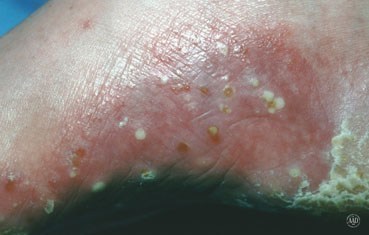
Pustular psoriasis: This type of psoriasis causes pus-filled bumps that usually appear on the foot or hand.
Inverse psoriasis
(also called flexural psoriasis or intertriginous psoriasis)
- Smooth, red patches of skin that look raw.
- Patches only develop where skin touches skin, such as the armpits, around the groin, genitals, and buttocks. Women can develop a red, raw patch under their breasts.
- Skin feels very sore where inverse psoriasis appears.
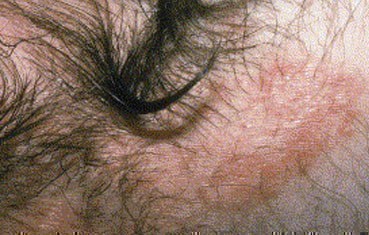
Inverse psoriasis: This type of psoriasis develops in areas where skin touches skin, such as the armpit.
Erythrodermic psoriasis
(also called exfoliative psoriasis)
- Skin looks like it is burned.
- Most (or all) of the skin on the body turns bright red.
- Body cannot maintain its normal temperature of 98.6° F. Person gets very hot or very cold.
- Heart beats too fast.
- Intense itching.
- Intense pain.
If it looks like a person has erythrodermic psoriasis, get the person to a hospital right away. The person’s life may be in danger.
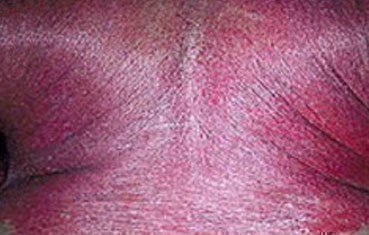
Erythrodermic psoriasis: This type of psoriasis can cause the skin to look like it is badly burned.**
Diagnosis, Treatment and Outcome
How does a dermatologist diagnose psoriasis?
To diagnose psoriasis, a dermatologist:
- Examines a patient’s skin, nails, and scalp for signs of psoriasis.
- Asks whether family members have psoriasis.
- Learns about what has been happening in the patient’s life. A dermatologist may want to know whether a patient has been under a lot of stress, had a recent illness, or just started taking a medicine.
Sometimes a dermatologist also removes a bit of skin. A dermatologist may call this confirming the diagnosis. By looking at the removed skin under a microscope, one can confirm whether a person has psoriasis.
How do dermatologists treat psoriasis?
Treating psoriasis has benefits. Treatment can reduce signs and symptoms of psoriasis, which usually makes a person feel better. With treatment, some people see their skin completely clear. Treatment can even improve a person’s quality of life. Our providers have an arsenal of ways to treat psoriasis and will analyze your unique condition to determine the best treatment.
Outcome
Psoriasis is a chronic (long-lasting) disease of the immune system. It cannot be cured. This means that most people have psoriasis for life. By teaming up with a dermatologist who treats psoriasis, you can find a treatment plan that works for you.
Dermatologists encourage their patients who have psoriasis to take an active role in managing this disease. By taking an active role, you can reduce the effects that psoriasis has on your quality of life. Book an appointment with one of our providers and start your journey to healing today! Call us at 757-622-6315 or request an appointment.



